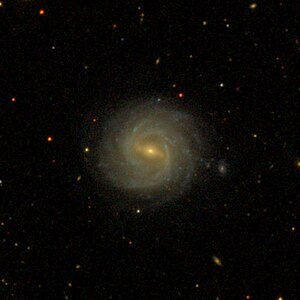NGC 5327
| Galaxy NGC 5327 |
|
|---|---|

|
|
| SDSS | |
| AladinLite | |
| Constellation | Virgin |
|
Position equinox : J2000.0 , epoch : J2000.0 |
|
| Right ascension | 13 h 52 m 04.2 s |
| declination | -02 ° 12 ′ 24 ″ |
| Appearance | |
| Morphological type | SAB (rs) b: / LINER |
| Brightness (visual) | 13.0 likes |
| Brightness (B-band) | 13.8 mag |
| Angular expansion | 1.9 ′ × 1.6 ′ |
| Position angle | 90 ° |
| Surface brightness | 14.1 mag / arcmin² |
| Physical data | |
| Affiliation | WBL 469-002 |
| Redshift | 0.014557 ± 0.000010 |
| Radial velocity | 4364 ± 3 km / s |
|
Stroke distance v rad / H 0 |
(193 ± 13) · 10 6 ly (59.1 ± 4.1) Mpc |
| history | |
| discovery | Wilhelm Herschel |
| Discovery date | April 15, 1787 |
| Catalog names | |
| NGC 5327 • UGC 8768 • PGC 49234 • CGCG 017-078 • MCG + 00-35-021 • IRAS 13494-0157 • 2MASX J13520418-0212233 • GC 3675 • H II 685 • h 1683 • GALEX ASC J135204.10-021223.0 • | |
NGC 5327 is a 13.0 mag bright bar-spiral galaxy with an active nucleus of the Hubble type "SBb" in the constellation Virgo on the ecliptic . It is estimated to be 193 million light years away from the Milky Way and has a diameter of around 110,000 ly.
In the same area of the sky is the galaxy NGC 5345 .
The object was discovered on April 15, 1787 by Wilhelm Herschel with an 18.7-inch reflector telescope, who described it as "F, pL, iR, following and parallel with 2 faint stars".
